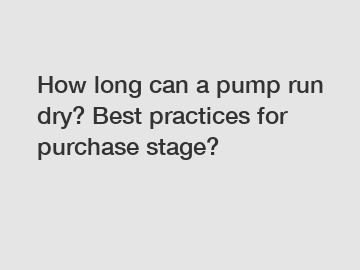How long can a pump run dry? Best practices for purchase stage?
Pumps are essential in many industries for various applications, such as transferring fluids, boosting water pressure, and maintaining machinery operations. However, one common issue that can damage a pump is running it dry. When a pump operates without any liquid to pump, it can cause overheating, cavitation, and mechanical failure. In this article, we will explore how long a pump can run dry and best practices for purchasing a pump to prevent this issue.
**How long can a pump run dry?**.
The length of time a pump can run dry without sustaining damage depends on several factors, including the pump type, material, and operating conditions. In general, centrifugal pumps, which are the most common type used in industrial settings, can sustain running dry for only a few seconds to a couple of minutes. These pumps rely on the fluid being pumped to provide lubrication and cooling, so running them dry can quickly lead to damage.

On the other hand, some positive displacement pumps, such as diaphragm or peristaltic pumps, are designed to handle dry running situations better. These pumps use mechanisms that do not rely on the fluid for lubrication, making them more resilient to running dry for extended periods. However, regardless of the pump type, it is always best to avoid running a pump dry to ensure its longevity and performance.
**Best practices for purchase stage**.
When purchasing a pump, there are several best practices you can follow to prevent running it dry and prolong its lifespan:
1. **Select the right pump type**: Choose a pump that is suitable for the application and operating conditions. Consider factors such as flow rate, pressure requirements, and the fluid being pumped to ensure the pump can handle the job effectively.
2. **Install proper safeguards**: Implement safety measures such as flow sensors, level switches, and pressure gauges to monitor the pump's operation and prevent it from running dry. These devices can provide early warning signs of low fluid levels or system malfunctions.
3. **Maintain regular inspection and maintenance**: Schedule routine inspections and maintenance checks for the pump to detect any issues early on. Clean the pump regularly, replace worn-out parts, and ensure proper lubrication to prevent operational problems.
4. **Train operators**: Provide comprehensive training for pump operators on proper use, maintenance procedures, and troubleshooting techniques. Educated operators can identify potential issues and take corrective actions to prevent damage to the pump.
By following these best practices during the purchase stage, you can minimize the risk of running a pump dry and maximize its efficiency and longevity. Investing in a high-quality pump and implementing preventive measures can save you time and money in the long run by avoiding costly repairs or replacements.
In conclusion, running a pump dry can lead to significant damage and reduce its lifespan. To prevent this issue, it is crucial to choose the right pump type, install proper safeguards, maintain regular inspections, and train operators. By following these best practices during the purchase stage, you can ensure your pump operates smoothly and efficiently for years to come.
If you have any questions or need assistance with selecting the right pump for your application, feel free to contact us.
If you are looking for more details, kindly visit diaphragm air pump works, uses for reciprocating pumps, aodd pump suppliers.
175
0
0


Comments
All Comments (0)